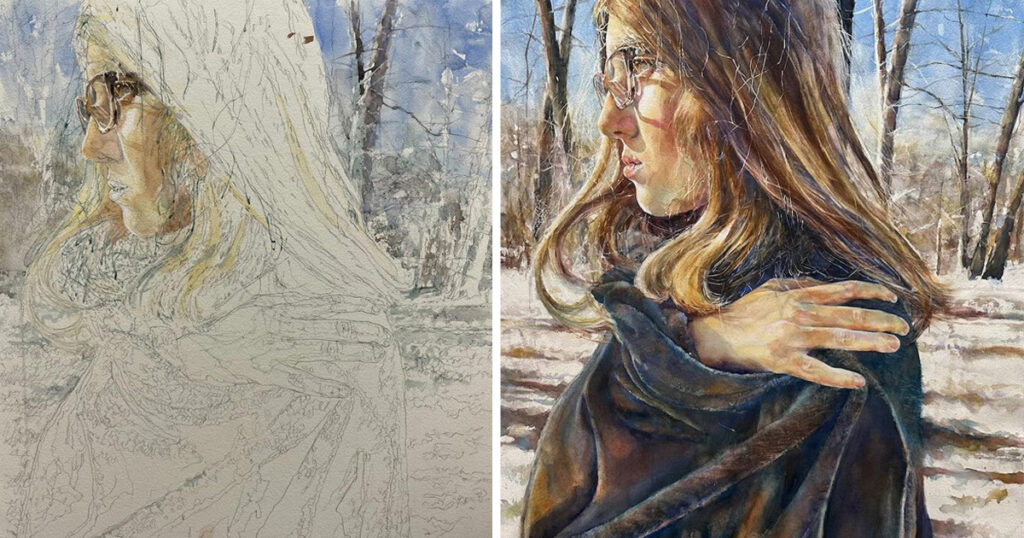Elements of a Still Life Painting | A Step-by-Step from Sheldon Tapley

By Sheldon Tapley

With theatrical splendor, Sheldon Tapley celebrates excess, reinventing the still life tradition by incorporating the figure and complicating the design. Here, he gives instruction on the elements of a still life painting.

1. Transferring the Drawing
I usually begin with a drawing (not shown here), which I transfer, using Saral transfer paper, to the primed aluminum laminate panel. I brush transparent red oxide thinly over the transferred lines and let them dry.
.
2. Blocking In
I use a hog bristle bright brush to scrub in a thin, flat layer of color. If the paint doesn’t flow easily, I add a drop of mineral spirits.
.
3. Choosing One Area
I choose one area, usually a key object in the composition and, using bristle brushes, add detail to it. This is just a first pass, so I avoid getting too detailed. For this piece, I made some of the edges on the table with a ruler; other edges, like those on the gourd, I kept soft. If the paint doesn’t flow easily enough, I add a drop of M. Graham walnut alkyd medium. At this point, I wouldn’t use mineral spirits in the paint because mineral spirits can dissolve the binder. .

4. Developing One Area
I worked up the gourd in greater detail; I added its shadow and developed the background around it. I wanted to see the character of the gourd clearly before I progressed to other areas.
.
5. Establishing the Quality of Light
Still undecided about how to handle the light coming in from the window, I wondered whether I should include the shadow cast on the wall by the window wall. Eventually, I did, but here I was thinking that the table and objects should be suffused with light. I applied the green paint of the background wall generously; then blended it to a flat surface using large, soft, badger brushes. I allowed the light to flood across the edge of the pitcher to avoid building up thick paint at the boundary of the object.
.
6. Developing Another Object
The flat, blocked-in pitcher became a three-dimensional object and acquired a shadow to attach it to the table plane.
.
7. Within the Reflection
I worked up the table and the pitcher in greater detail. The reflection of Danville’s Main Street in the pitcher was so clear that it was like watching a little movie. I began to wonder if I was crazy to try to paint the scene! What you see here, the scene in the reflection, is the result of many tries.
.
8. Making It Complex
I decided that the composition would benefit from including the shadow on the right part of the back wall. I described, too, the wall surface in greater detail. My initial plan, to make a simple design emphasizing two forms on the table, gave way to my persistent need for complication: I added a piece of rope. .

9. Adding Elements
A rope needs scissors! Not everything in a still life has to fit together thematically, but this juxtaposition is one I often enjoy painting. Also, I love the form of these scissors. The plastic handles have a dynamic, subtle design, as if the designer had been looking at Brancusi or Noguchi. I drew the scissors with blue-gray paint thinned with M. Graham walnut alkyd medium because I was impatient to finish and I wanted these last stages to dry quickly.
.
10. Making Modifications
I was dissatisfied with the right edge of the pitcher, where the dust on it caught very strong light. I’d reworked this difficult passage so much that there was a distracting ridge built up along the contour of the pitcher, so I sanded the area gently with 600-grit sandpaper, as a prelude to reworking it with smoother paint. The scissors were nearly done; the cast shadows of the gourd and scissors would become more intensely warm. .

11. Seeking Transparency
Some of the last layers were glazes, in which I used more medium to allow transparency in colors like the blues and purples of the pitcher in Dust (oil on aluminum laminate panel, 16×20).
To learn more about Sheldon Tapley, visit his website at sheldontapley.com.
You may also like:
- Sheldon Tapley and the Not-So-Still Life





Have a technical question?
Contact UsJoin the Conversation!